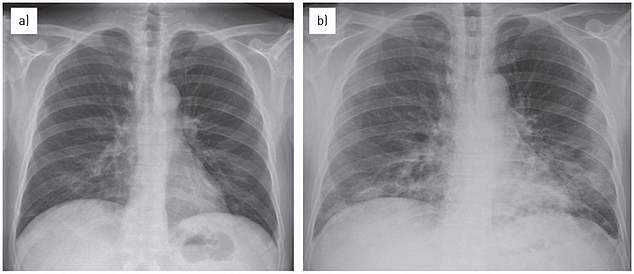What are the symptoms of Walking Pneumonia? Major surge in cases among children as map shows rapid spread of respiratory illness
Doctors and parents are warning of a rise in walking pneumonia among American children — one year after a terrifying outbreak abroad.
The infection, also called ‘white lung pneumonia’, is caused by the bacterium Mycoplasma pneumonia and mainly affects young people aged two to four years old who were born during the Covid pandemic.
More than 10 percent of emergency room visits with pneumonia in this age group were diagnosed with the bacteria at its peak in August.
But what are the symptoms of this terrible disease?
The symptoms may come on suddenly or may take longer to occur, making the condition difficult to diagnose. KidsHealth.org suggests that if cold symptoms last longer than 7 to 10 days, it may be a sign of ongoing pneumonia.
More than 10 percent of emergency room visits with pneumonia in this age group were diagnosed with the disease at its peak in August

The white masses in the lungs represent fluid-filled air sacs that infectious disease experts say indicate mycoplasma pneumonia
Although the symptoms of the infection in question are very similar to those of a common cold, here are some tell-tale signs to look out for:
- Fever of 101 degrees Fahrenheit or lower
- A persistent, unrelenting cough that can last for weeks to months
- General fatigue
- Headache, chills, sore throat and other flu-like symptoms
- Difficulty breathing or wheezing
- Earache
- Chest pain
- Vomiting
- Loss of appetite
- Rash
- Joint pain
Symptoms usually depend on where the infection is concentrated. A child whose infection is in the upper or middle part of the lungs will likely have difficulty breathing. Another whose infection is in the lower part of the lungs may not have breathing problems, but may experience stomach upset, nausea, or vomiting.

Alma Geddes, three, was one of several children doctors at Greater Baltimore Medical Center have seen with pneumonia so far this year
Normally, children with this type of pneumonia don’t feel sick enough to stay home — hence the name “walking pneumonia” — but even a child who feels well should stay home for a few days until symptoms improve, KidsHealth.org advises.
A five- to 10-day course of oral antibiotics is usually recommended as an effective treatment for the condition, experts say.
After starting antibiotics, the infected child is less likely to pass the disease on to other family members. However, it is strongly encouraged that those experiencing symptoms do not share drinking glasses, eating utensils, towels, or toothbrushes.
With treatment, most forms of bacterial pneumonia clear up within 1 to 2 weeks, but persistent coughing may take up to 4 to 6 weeks to resolve.
